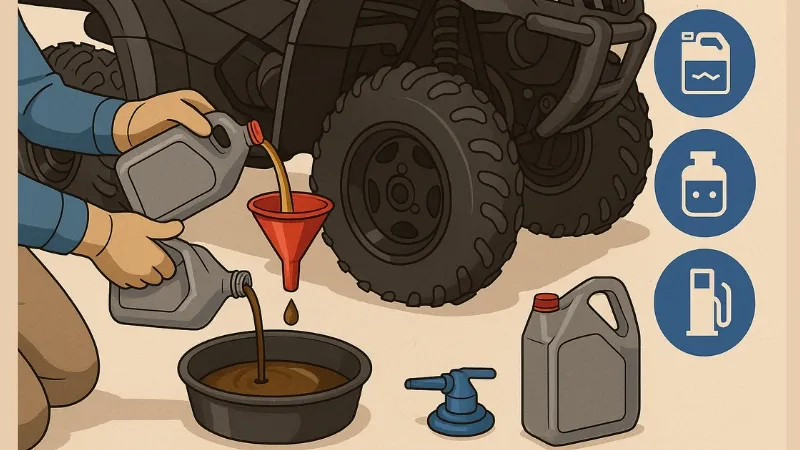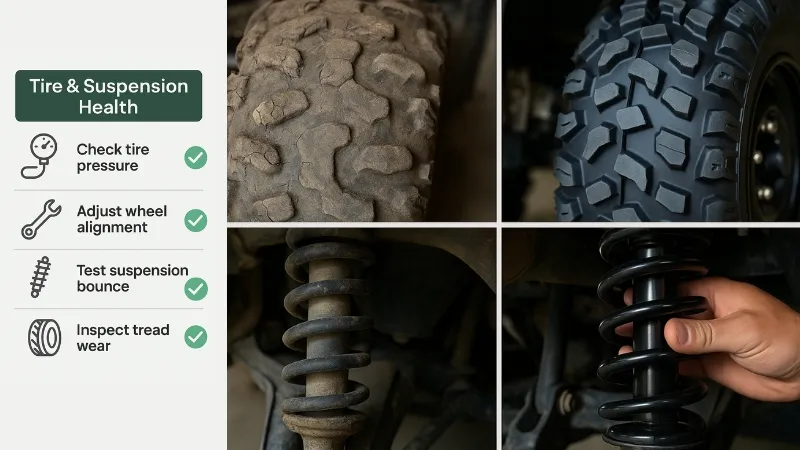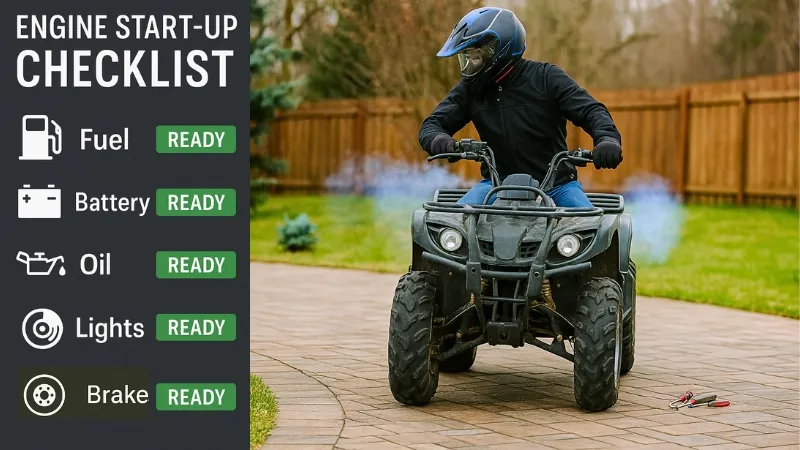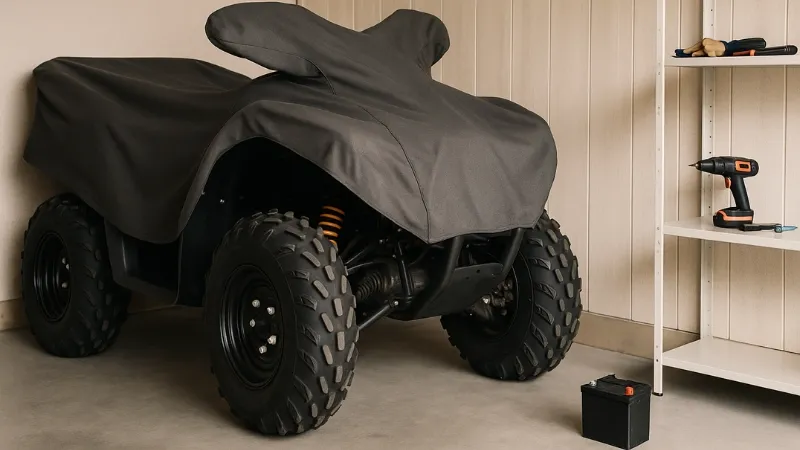If your ATV has been hibernating for months or even years, it needs more than just a key turn to roar back to life.
When your four-wheeler has been sitting idle, fluids thicken, seals dry, and batteries lose their spark. But don’t worry — reviving your ATV after long-term storage is easy when you know what to look for.
In this guide, you’ll learn how to safely bring your machine back to life using simple, reliable ATV maintenance tips and a solid inspection routine that gets you back on the trail fast.
So, it’s time to get your hands dirty and start where every good revival begins — with a full visual inspection.
Read: What to Do If ATV Makes Buzzing Sound When Trying to Start
Jump To Contents
- Step 1: Conduct a Thorough Visual Inspection
- Step 2: Refresh the Fluids
- Step 3: Reawaken the Battery
- Step 4: Inspect Tires and Suspension
- Step 5: Test and Start the Engine Safely
- Preventive Maintenance: Keep Your ATV Ready All Year
- Helpful Gear for Waking Up Your ATV
- Final Post-Storage Walkthrough
- Ready, Set, Ride! Revive Your ATV Like a Pro
- Frequently Asked Questions – FAQs
Step 1: Conduct a Thorough Visual Inspection

Before turning on the ignition to start your ATV, give it a thorough once-over to catch issues before they become expensive fixes.
ATVs collect more than dust when stored — rodents, rust, and moisture love inactive machines. Start with a slow, patient visual inspection to ensure your ride is safe to work on. Think of it as a friendly “hello” to your machine before you wake it up.
Inspection Checklist:
- Check for leaks: Look for oil, fuel, or coolant drips under the chassis.
- Inspect wiring: Watch for corrosion or rodent damage on cables and connectors.
- Brake lines: Make sure hoses aren’t brittle or leaking.
- Clean surfaces: Wipe away grime, cobwebs, and rust buildup.
- Tighten loose hardware: Bolts, nuts, and covers should all be snug.
Tip: Use an ATV inspection checklist every season — it keeps maintenance consistent and organized.
Do not get intrigued if everything looks solid on the outside, because inside, your ATV’s fluids have likely gone stale. In that case, the heart of your machine — its fluids — awaits a well-deserved refresh.
Step 2: Refresh the Fluids

Old fluids lose their protective qualities and can damage vital components — so refresh everything before your first start-up.
When oil sits too long, it separates and collects moisture; fuel can become stale and gummy. These silent problems can lead to poor performance or engine failure. Replacing fluids is one of the easiest ways to extend your ATV’s life and performance.
Fluid Refresh Steps:
- Engine oil and filter: Drain, replace, and dispose of old oil responsibly.
- Coolant: Flush and refill — old coolant can corrode engine parts.
- Brake fluid: Replace if over a year old or cloudy.
- Fuel system: Empty the tank, clean fuel lines, and refill with fresh gas.
- Transmission/differential: Check fluid color and top off as needed.
Pro Tip: Next time you store your ATV, add a fuel stabilizer — it keeps gasoline fresh for months and prevents carburetor clogs.
Now that your ATV’s lifeblood is renewed, it’s time to bring back the spark — literally. The next step ensures your battery wakes up as strong as the day you parked it.
Read: How to Fix Dead ATV Battery in 8 Steps
Step 3: Reawaken the Battery

A weak or dead battery is the number one reason an ATV won’t start after storage — but it’s easy to fix.
Batteries naturally discharge when idle, especially in cold environments. Before you turn the key, test your ATV battery to check the voltage and give your battery a little TLC. A healthy charge ensures a smooth start-up and keeps electrical systems running properly.
Battery Revival Tips:
- Clean terminals: Remove corrosion with a mix of baking soda and water.
- Check voltage: Anything below 12.4V needs charging; below 11.8V likely needs replacing.
- Trickle charge: Use a smart charger for a slow, safe charge.
- Inspect cables: Make sure they’re tight, undamaged, and secure.
- Prevent drain: Use a battery maintainer if storing long-term.
Bonus Tip: Label your battery with the last charge date — it’s an easy ATV maintenance tip that keeps you organized.
Your battery’s now back in action, but before you hit the trail, don’t forget about the parts that meet the ground. It’s time to check those tires and suspension so your ride feels as smooth as it sounds.
Read: ATV Tires Buying Guide: Crucial Factors to Consider
Step 4: Inspect Tires and Suspension

ATV Tires and suspension often suffer quietly during storage — don’t hit the trail without checking them first.
Rubber naturally degrades, losing pressure or cracking, or beads leaking over time. Likewise, shocks can stiffen, and bearings may rust. Before riding, spend a few minutes inspecting your tires and suspension for signs of wear or stress. This not only keeps your ride smooth but also prevents accidents.
Tire & Suspension Checklist:
- Tire pressure: Inflate to the recommended PSI (found in your manual).
- Sidewalls: Look for cracks or bulges — replace if damaged.
- Wheel bearings: Spin each wheel and listen for grinding or wobbles.
- Suspension joints: Check for rust, leaks, or stiffness in shocks.
- Steering alignment: If it feels off-center, get it professionally adjusted.
Pro Tip: Keep a digital tire gauge in your toolkit — consistent pressure improves performance and saves fuel.
Your ATV now stands tall and balanced, ready to move. But before you take it for a spin, there’s one more critical test — getting that engine to purr again without a hitch.
Read: An In-depth Guide to Testing ATV Starter
Step 5: Test and Start the Engine Safely

Key Point: Starting your ATV after months of rest requires patience — rushing can cause real damage.
Before firing up, make sure everything’s properly connected, oiled, and secure. Your goal is to reintroduce motion gently, allowing fluids to circulate and seals to reseat. Think of this like waking up your ATV with a good stretch before the sprint.
Safe Start Procedure:
- Prime the system: Pump the throttle or primer bulb to circulate fuel.
- Start and idle: Let it run for a few minutes before revving up.
- Listen carefully: Unusual noises? Shut it down and inspect.
- Check controls: Test throttle, brakes, and lights before moving.
- Short test ride: Cruise slowly in an open area to verify smooth operation.
Tip: Watch the temperature gauge — overheating early means coolant or fan issues.
Your engine’s alive again, and that first rumble feels good. But to keep it that way, let’s talk about preventive maintenance — the secret to avoiding this whole revival routine next time.
Read: Why Is My ATV Overheating? – Causes, Fixes, and Prevention Guide
Preventive Maintenance: Keep Your ATV Ready All Year

The best way to avoid storage headaches is to ensure pre-storage rituals are observed properly. But preventive maintenance keeps your ATV in shape year-round.
Once your machine is running smoothly again, set up a routine that prevents future issues. Preventive care is simpler and cheaper than emergency repairs — and it keeps your rides worry-free.
Maintenance Habits to Adopt:
- Follow a schedule: Clean, lube, and inspect every month.
- Winterizing ATV: Drain old fuel, remove the battery, and cover it properly.
- Cover it up: Use a breathable cover to protect from dust and moisture.
- Keep notes: Log oil changes, battery checks, and rides in a notebook.
- Start it periodically: Run your engine every few weeks to keep fluids moving.
Bonus Tip: Ask your local dealer for a seasonal ATV inspection checklist — it’s often free and super helpful.
You’ve mastered maintenance habits, but the right tools can make every step quicker and easier. Let’s check out some must-have gear that makes waking up your ATV a breeze.
Helpful Gear for Waking Up Your ATV
The right tools make maintenance faster, easier, and safer — here are a few that every ATV owner should keep handy.
A small investment in maintenance gear saves you from frustration later. These essentials are beginner-friendly and can extend your machine’s lifespan while improving your ride experience.
Recommended Essentials:
- Battery maintainer: NOCO Genius 1 or Battery Tender Plus — keeps your battery healthy during storage.
- Fuel stabilizer: STA-BIL Storage Fuel Stabilizer — prevents gas breakdown and varnish buildup.
- Digital tire pressure gauge: AstroAI Digital Tire Inflator — ensures even pressure every time.
- All-purpose cleaner: Maxima SC1 Silicone Detailer — keeps plastic and metal parts clean and protected.
- Oil drain pan & funnel: Simple must-haves for mess-free oil changes.
Pro Tip: Store your gear in a dedicated crate or cabinet so you’re always ready for pre-ride checkups.
Now that you’re fully equipped, let’s tie it all together with one last quick walkthrough before you take your ATV for its long-awaited spin.
Final Post-Storage Walkthrough
Before you call your ATV “ready,” take five minutes to double-check everything — it’s the last step for safe, confident riding.

You’ve done all the hard work; this walkthrough ensures you didn’t miss anything important. Think of it as your quick pre-ride mission checklist.
Quick Recap Checklist:
✅ No visible leaks, loose bolts, or corrosion.
✅ All fluids topped off and fresh.
✅ Battery charged, clean, and properly connected.
✅ Tire pressure balanced and no dry rot.
✅ Lights, brakes, and throttle working properly.
✅ Suspension feels smooth — no squeaks or stiffness.
✅ Engine starts clean, idles smoothly, and runs cool.
✅ Test ride completed with no strange noises.
Tip: Keep this list printed or saved on your phone — it’s your go-to pre-ride ritual every season.
Read: How Fast Can an ATV Go?
Ready, Set, Ride! Revive Your ATV Like a Pro
Your ATV’s long nap is over — and you’ve brought it back with care, patience, and precision.
By following these five easy steps (plus the final walkthrough), you’ve ensured a safe, smooth return to the trails. From fluids and batteries to tires and tune-ups, your machine is now fully refreshed and ready to roar again.
So what are you waiting for?
Grab your helmet, check your ATV maintenance checklist, and hit the dirt with confidence. Whether it’s your first ride of the year or your first after years — your revived ATV is ready for the adventure ahead.
Frequently Asked Questions – FAQs
1. How long can gas sit in an ATV before it goes bad?
Gasoline can start breaking down in as little as 30 days, depending on storage conditions. After a few months, it can gum up your fuel system and carburetor. If you plan to store your ATV longer than a month, add a fuel stabilizer to keep the gas fresh. Always drain and refill the tank with fresh fuel before starting after long storage.
2. Can I use the same oil after long-term storage?
It’s best not to. Even if your ATV hasn’t been ridden, oil can collect condensation, debris, and lose its protective properties. Replacing it ensures your engine stays lubricated and avoids unnecessary wear. Think of it as cheap insurance for your motor’s health.
3. How do I know if my ATV battery is still good?
Check the voltage with a multimeter — anything between 12.4V to 12.8V is healthy. Below that, give it a slow charge with a maintainer. If it won’t hold a charge or drops quickly, it’s time to replace it. Clean the terminals too, as corrosion often causes power loss. A quick load test at an auto shop can also confirm if your battery still has life left in it.
4. Should I change coolant after storage?
Yes, especially if it’s been over a year. Coolant can lose its anti-corrosive properties and lead to rust or buildup inside your cooling system. Flushing it ensures efficient temperature control. It’s a small effort that prevents overheating and extends engine life.
5. Why does my ATV smoke after being stored?
A bit of smoke at startup is normal — oil may have settled in the combustion chamber. However, excessive or continuous smoke could mean bad fuel, worn rings, or overfilled oil. Let it idle for a few minutes; if it doesn’t clear, shut it down and inspect further. In some cases, using a fuel system cleaner or replacing spark plugs can help burn off leftover deposits.
6. How often should I start my ATV during long-term storage?
If possible, start it once every 3–4 weeks and let it idle for 5–10 minutes. This keeps fluids circulating and prevents seals from drying out. If that’s not possible, use fuel stabilizers and disconnect the battery to minimize long-term damage.
Relevant reads include: